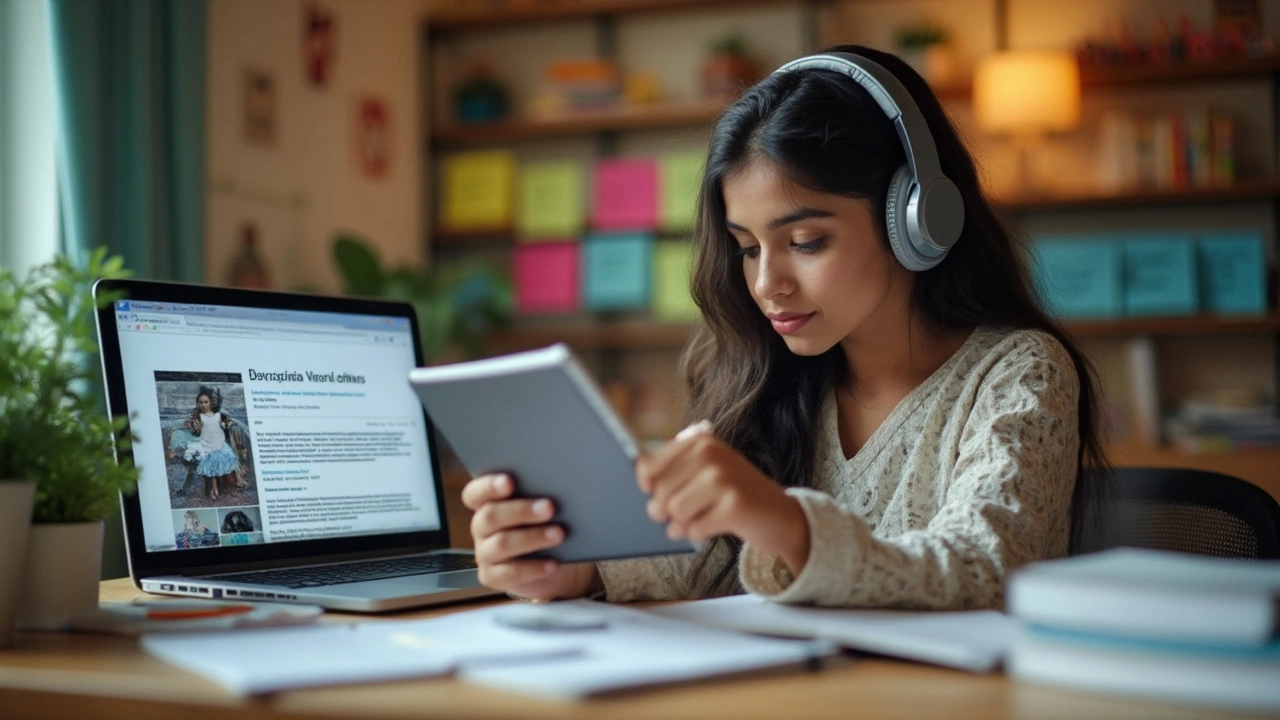How to Improve English Quickly at Home: Simple Steps for Fast Progress
 Jun, 10 2025
Jun, 10 2025
Tired of memorizing grammar rules and still not feeling confident in English? You’re not alone. The fastest way to improve your English at home isn’t reading thick textbooks—it’s about working English into your real, daily life. Sounds simple, but most people skip the obvious steps.
First thing: start speaking out loud, even if you’re alone. Talk about your day, ask yourself questions, or comment on what you see around you—in English. This builds confidence and gets your brain used to thinking in a new language. If you mess up, who cares? No one’s there to judge.
Don't just study—use English as often as you can. Whether you’re making coffee or scrolling social media, try switching the language or describing what you’re doing in English. This way, English stops being a ‘subject’ and starts being a normal part of your routine. That’s where real progress happens.
- Start Speaking from Day One
- Make English Part of Daily Life
- Tech Tools: Your Secret Weapons
- Listening That Actually Works
- Track Progress and Stay Motivated
Start Speaking from Day One
If you want to improve English fast, speaking is non-negotiable. You don’t need fancy courses or a big group. All you really need is the will to open your mouth and start talking. Research from Cambridge University shows that speaking from the very start—even at a beginner level—gets your brain used to connecting thoughts with words. When you speak, you practice using new grammar and words in real time, which helps you remember them much quicker.
Here’s how you can make speaking part of your day from the get-go:
- Talk to yourself while doing chores. Describe what you’re doing out loud in English: “I am washing the dishes” or “Now I will make some tea.” Don’t worry about making mistakes; you’re building fluency, not showing off.
- Use your phone’s voice recorder to practice short stories about your day or topics you care about. Listen back—it feels awkward at first, but you’ll hear where you can improve.
- Find online speaking partners. Sites like iTalki or free language exchange apps connect you to people who want to practice English or offer conversation time in return.
- Challenge yourself to short daily speaking tasks. For example, talk for one minute about a news headline or your plans for the weekend. Start small and gradually tackle bigger topics.
- Repeat phrases you hear in shows or YouTube videos. Imitation doesn’t just help with pronunciation, it also builds confidence and natural flow.
Don’t wait until you feel "ready." That day never comes. The more you speak, the easier English gets, and those flustered moments turn into smooth conversations way faster than you expect.
Make English Part of Daily Life
If you want to actually start using English better and quicker, weave it right into your daily routine. The more you see and hear English, the less foreign it feels. No need for a major lifestyle change—just small tweaks that add up fast.
Change the language on your phone and computer settings to English. It seems simple, but now every time you unlock your phone or open an app, you’re practicing. This trick nudges your brain to connect regular actions with new words and phrases without extra study time.
Another underrated move—label stuff around your house. Stick a note saying “mirror,” “door,” or “fridge” on things you use a lot. Glancing at these labels dozens of times a day drills the vocabulary into your head without you even trying. It’s a proven memory hack called “spaced repetition”—science backs up how well it works.
Make your entertainment double as practice. Pick one English TV show, podcast, or YouTube channel and follow it daily. Keep the subtitles on in English, not your native language. Your brain connects the written and spoken word, so you pick up natural phrasing and pronunciation at the same time.
- Write your grocery lists, reminders, or social media posts in English.
- Call a friend (or even talk to your pet) in English for 5 minutes a day.
- Read recipes or news in English instead of your first language.
The more improve English becomes part of your day, the less it feels like a chore. Think of it as upgrading tiny habits, not forcing big changes. Every bit of real-life exposure gets you closer to your goal.

Tech Tools: Your Secret Weapons
If you want to improve English fast, the right apps and gadgets are like having a tutor in your pocket. There are tons of free and cheap tools that make learning almost automatic. The trick is to use them smartly—and not just download and forget about them.
Language apps like Duolingo and Cake turn practice into a game. You get short, daily lessons that fit into bathroom breaks or bus rides. If you’re more into talking than filling blanks, try HelloTalk or Tandem. These connect you with real people worldwide for text or voice chats. A 2023 report from The Guardian even highlighted how language exchange apps help users gain confidence and natural speaking skills.
Don’t skip YouTube for listening practice. Search “English conversation for beginners” or “daily English speaking” and you’ll find real-life dialogues and lessons all day long. Even Netflix and Prime Video are goldmines—just switch on English subtitles and listen closely. Copy the way they say stuff; it’s like free pronunciation training.
“Technology has lowered the barriers to language learning. Anyone with a smartphone can now practice speaking, listening, and even get feedback 24/7.” — John Fotheringham, language coach and author
Voice assistants are another smart tool. Just ask Siri or Google Assistant questions in English. Don’t worry if you mess up—they don’t judge. If you want to check your accent, apps like ELSA Speak give real feedback on what you mispronounce and how to fix it.
- Set your phone and apps to English. Everything from Google Maps to alarms—force your brain to think in English every time you unlock your screen.
- Record yourself on your phone. Listen back, notice what words or sounds are tricky, and re-record until you’re happy. It’s awkward at first, but big progress happens here.
- Use WhatsApp voice messages to chat in English—even just with yourself or close friends who are learning too.
Bottom line? You don’t need expensive courses or a language lab. With basic apps and a bit of creativity, your phone or laptop becomes your own English classroom, available anywhere, anytime.
Listening That Actually Works
If you keep listening to slow, boring audio meant for beginners, you’ll stay stuck. People who learn English faster usually mix in real conversations, podcasts, and shows. There’s no magic—just smart choices in what you hear every day.
Native speakers usually talk around 150 words per minute in normal conversations. That’s way faster than basic English listening exercises you get in textbooks. A 2024 study by the British Council found that learners who spent 20 minutes daily on real-life English audio improved comprehension 40% more than those who used only scripted, slow content.
So, ditch the textbook CDs and go for things you actually want to listen to. Pick YouTube videos, casual podcasts, or even stand-up comedy clips. Subtitles help at first, but try to challenge yourself without them as you get better. Here are some easy steps to get your ears used to English:
- Start with topics you know. If you love football, watch English match commentaries. Already know the rules and players, so it’s easier to follow.
- Listen more than once. The first time, just try to get the main idea. Second time, listen for details or new words.
- Use the pause button a lot. Stop to write down new phrases or repeat what you hear out loud.
- Don’t be afraid of accents. Switch between British, American, Indian, or Australian videos. Real-life English isn’t just one accent.
Some popular resources for better listening include:
- ESLPod and Luke’s English Podcast for everyday topics.
- BBC Learning English YouTube channel for clear explanations with real news.
- Netflix shows or movies with the subtitles toggled off and on.
| Weeks | Words Caught per Minute |
|---|---|
| 1 | 50 |
| 4 | 90 |
| 8 | 125 |
| 12 | 150+ |
The key is to keep it interesting and regular. Mix up sources, challenge yourself, and make sure you’re listening to real, everyday English. This way, you’ll notice your improve English goal getting closer much faster than you’d expect.

Track Progress and Stay Motivated
Learning a language at home can feel endless, especially when you’re not sure if you’re actually getting better. The trick is to see your small wins and celebrate them, so you don’t lose steam along the way.
Start by picking solid checkpoints. For example, record a 30-second video of yourself speaking English at the end of each week. Compare these clips every month—you’ll quickly notice your pronunciation and fluency improving, even if you didn’t feel it day to day. This approach is way more honest than just trusting a gut feeling.
Another proven way to measure progress is using digital language trackers. Apps like Duolingo and Memrise keep count of your learning streaks, vocabulary words, and time spent in practice. Even the most basic notes app works if you jot down new words or phrases you’ve learned daily. Consistent tracking turns the climb to fluency into a series of short sprints.
Motivation will dip now and then. To keep going, set tiny, clear goals—like having a five-minute chat in English or watching a YouTube video without subtitles. If you reward yourself each time you nail a goal, even with something small like your favorite snack, your brain connects learning with feeling good. That helps you stick with it, even on tough days.
- Pick one main area to focus each week (like speaking, listening, or reading)
- Share progress with a friend or language buddy—they’ll keep you honest
- Write a to-do list every Sunday for the upcoming week’s English goals
- Keep reminders around your home—sticky notes or alarms work wonders
When you can literally see yourself getting better, giving up feels silly. It’s not magic, just smart tracking and keeping your eyes on your improve English goal.